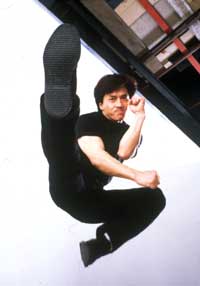The Martial Arts: A Belt from the East

The martial arts have a long history. “Martial” comes from Mars, the Roman god of war, and the planet Mars received its name because of its red color, which was thought to resemble the heat and fire of battle. The martial arts were once used only for self-defense and were not even known in the U.S. when your grandparents were children. It wasn't until 1964 that judo was accepted as an Olympic sport. Today we know karate, aikido, kung fu, and many others as rigorous sports that demand great skill and many years of training.
 AP Photos |
Popular Martial Arts in the U.S.: Where Are They From?
| China | Kung fu |
| Northern and southern Shaolin boxing | |
| Tai chi | |
| Japan | Karate |
| Judo | |
| Aikido | |
| Kendo | |
| Jiu jitsu | |
| Ninjutsu | |
| Korea | Tae kwon do |
| T'ang su do | |
| Hwarang do |
Aikido
Aikido, “the way of all harmony,” is a purely defensive art. The defender, or tori, attempts to divert harm from him- or herself without causing injury to his or her opponent, or uke. Working at arm's length, using a series of arm and wrist holds and getting momentum from the hips and legs, the tori attempts to throw the uke to the ground. The tori must try to “blend” with the uke to redirect momentum, much like taking control of a runaway vehicle. To do this, the tori steers away oncoming strikes from his opponent. Aikido unites the mind, the body, and a source of energy from the mind called ki to accomplish its aim.
Jiu Jitsu
Jiu jitsu is the Japanese samurai's unarmed system of fighting. It's practiced by the military as a means of self-defense. A combination of strength, balance, leverage, timing, and speed are used to defeat one's opponent. By using one's power or leverage on an elbow or wrist joint, the opponent can be held in a painful position and may give up.
Judo
Judo, “the gentle way,” was the first martial art accepted at the Olympic games. In this sport, the object is to throw and pin one's opponent. Using a series of throws and choke holds, the judokas, or judo players, try to get each other down on the mat. One player must hold the other on the mat for 30 seconds to be declared the winner.
Karate
Karate, “empty hands,” is Japan's most popular martial art. Intense concentration is used to focus as much strength as possible on the object of impact. The feet, legs, elbows, head, and fists are used for kicking, punching, defensive blocking, and other techniques. Two types of contest are popular in sport karate. In kata, judges award points for techniques and timing. Kumite are sporting contests in which judges award points for well-timed attacking blows.
In karate contests, opponents are not allowed to actually strike each other. They must stop just short of making contact.
Kung Fu
Kung fu is the name given by Westerners to a range of Chinese fighting styles. The object of kung fu is to halt one's opponent using a variety of moves. Originally, there were five styles, which were based on animal movements. Now there are hundreds of different styles. The five most popular styles are tiger, crane, leopard, snake, and dragon, which, as a group, are called “the five animals fist.”
Ninjutsu
Ninjutsu, the Japanese art of the Ninja, was an art of stealth, meaning secret procedures. Ninjas had to be able to sneak around, as many of them were involved in espionage, or spying. Their training included instruction in unarmed combat, the use of traditional and specialized weapons, climbing devices, signals, codes, and disguises. Ninjas were ruthless fighters and would do anything to reach their goals. This art was banned in Japan in the 17th century, but it has gained popularity in the U.S. in the late 20th century. At the present time, there are only a few trained instructors in the U.S., and all are part of a Ninja family.
Belt Ranking System
Students of both karate and judo have the honor of wearing colored belts to indicate their ability. As they pass increasingly difficult tests, they are promoted to the next kyu, or grade.
Dan, or advanced grades, receive black belts, which are ranked from 1st to 10th dan. Some display their level by wearing one or more red tabs on their belt. For example, the 2nd level gets two red tabs.
Belt ranking systems can be different for the different types of karate and judo. And juniors (under the age of 17) and seniors often use different color systems. Here are some popular examples.
| Level | Karate | Judo |
|---|---|---|
| Novice (Beginner) | Red | White |
| 9th Kyu | — | Yellow |
| 8th Kyu | White | Orange |
| 7th Kyu | Yellow | Orange |
| 6th Kyu | Orange | Green |
| 5th Kyu | Green | Green |
| 4th Kyu | Purple | Blue |
| 3rd Kyu | Brown | Blue |
| 2nd Kyu | Brown | Brown |
| 1st Kyu | Brown | Brown |
